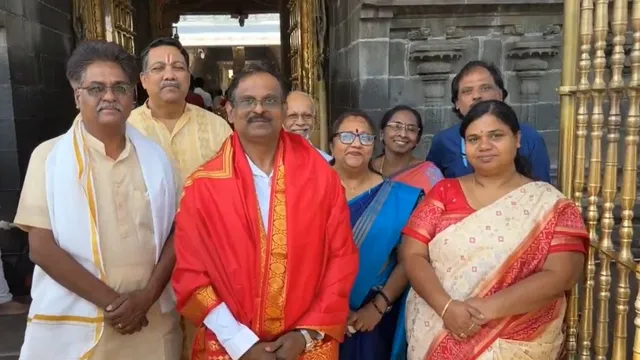- By Aashish Vashistha
- Tue, 28 Jan 2025 06:43 PM (IST)
- Source:JND
Ahead of India's much-anticipated GSLV-F15/NVS-02 rocket launch, ISRO Chairman Dr V Narayanan visited the Lord Venkateswara temple in Tirumala on Tuesday to offer prayers for the success of the mission. Accompanied by a team of ISRO scientists, Dr Narayanan placed a model of the rocket at the feet of the deity, as shown in visuals shared by news agency ANI. The team also conducted a special prayer seeking divine blessings for the upcoming launch.
"I am grateful that the Prime Minister has decided to sanction ₹400 crores for the third launch pad at ISRO, which would enable the launching of heavier rockets into space." Dr Narayanan told news agency ANI. He also stated that the new infrastructure would help in the launch of heavier rockets into space.
GSLV-F15 Launch
ISRO is gearing up for its 100th rocket launch from the Satish Dhawan Space Centre in Sriharikota on January 29. This milestone event will feature the GSLV-F15 rocket, set to lift off at 6:23 am from the second launch pad. The rocket will carry the NVS-02 navigation satellite into space. This launch marks a significant achievement for Sriharikota, which hosted its first major rocket launch—the Satellite Launch Vehicle (SLV)—on August 10, 1979.
The ISRO statement highlighted that GSLV-F15 is the 8th operational flight of the GSLV series equipped with an indigenous Cryogenic stage. For the first time, GSLV-F15 features a metallic payload fairing with a diameter of 3.4 meters.
The GSLV-F15 rocket, equipped with an indigenous Cryogenic stage, will place the NVS-02 satellite into Geosynchronous Transfer Orbit. This mission has the potential to further enhance the NavIC system, continuing its advancement with these new capabilities.
NavIC is India's homegrown regional navigation satellite system designed to provide precise Position, Velocity, and Timing (PVT) services to users in India and nearby regions.
NavIC offers two types of services: Standard Positioning Service (SPS) and Restricted Service (RS). The system ensures a position accuracy of better than 20 meters (2 seconds) and a timing accuracy of better than 40 nanoseconds (2 seconds) within its coverage area, according to official reports.

